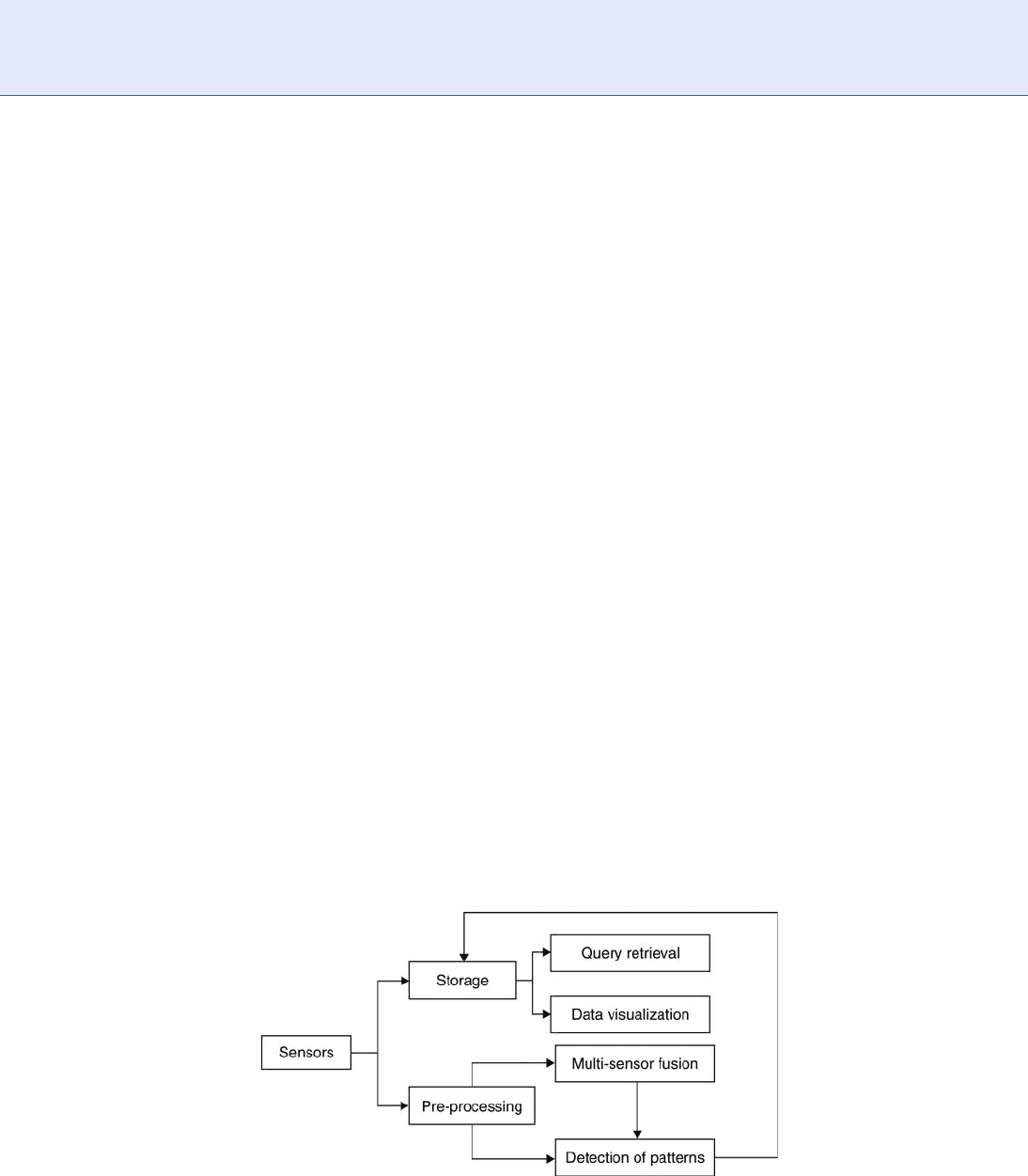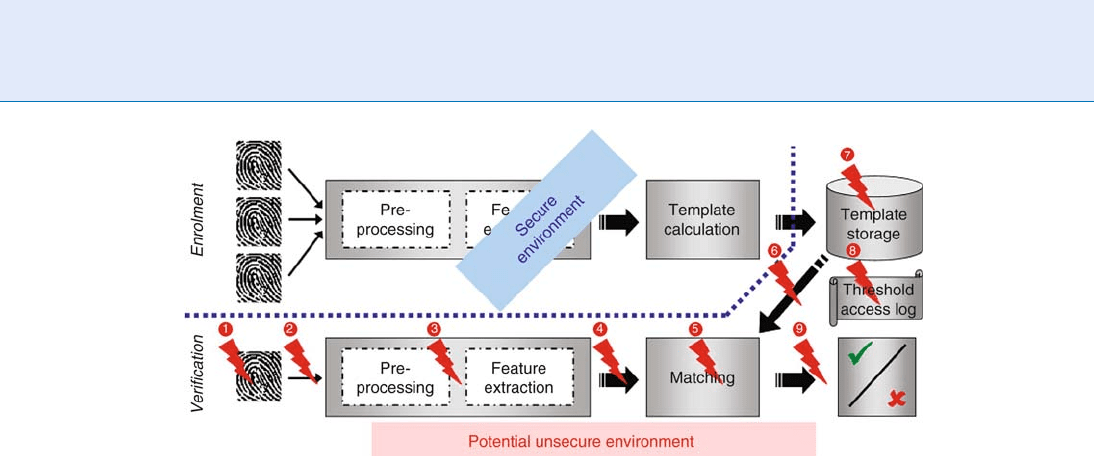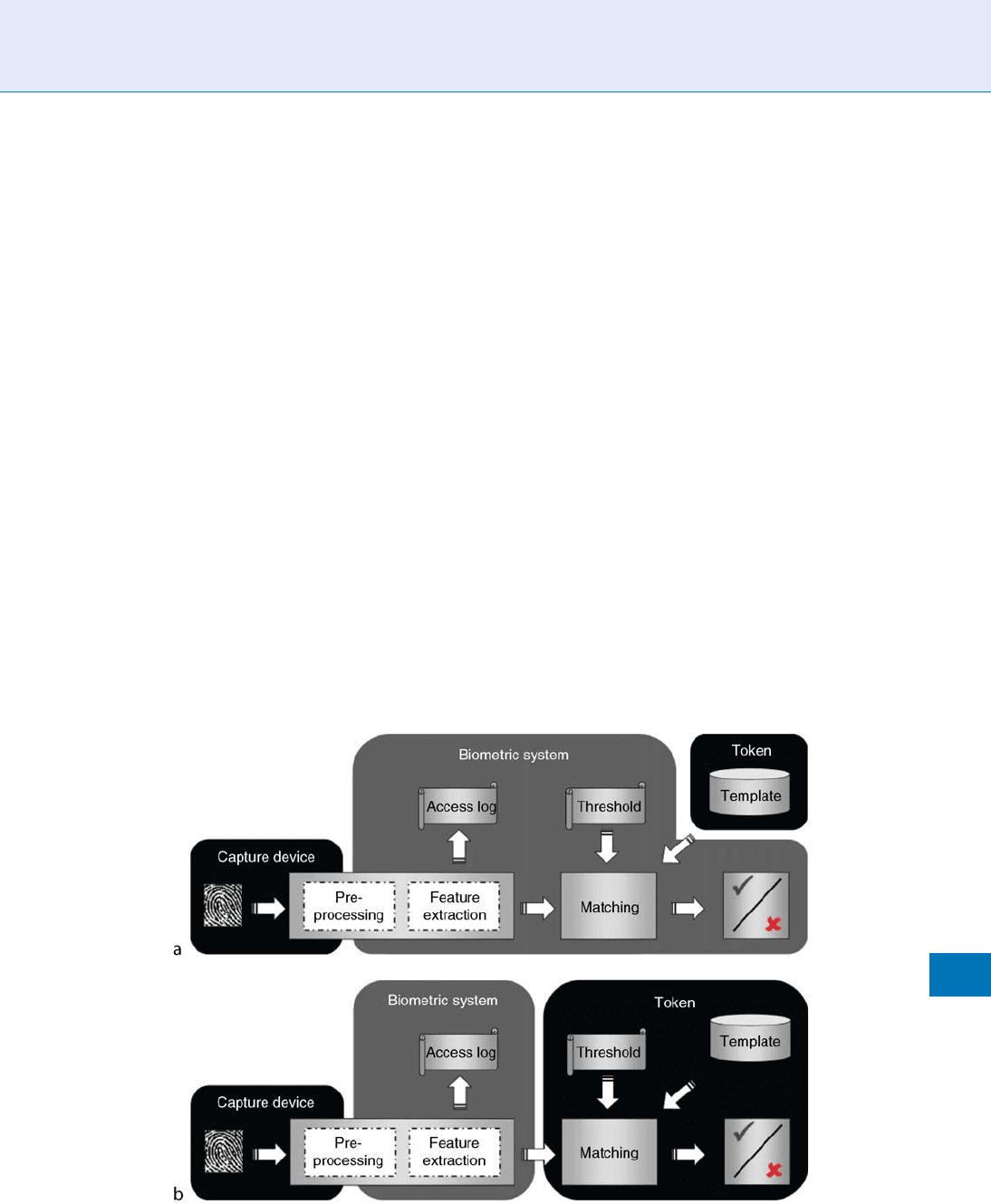Li S.Z., Jain A.K. (eds.) Encyclopedia of Biometrics
Подождите немного. Документ загружается.


other applicat ions [1] such as traffic monitoring,
wherein it is mainly used for detecting violations and
monitoring traffic. Typically, video cameras are find-
ing use for detecting congestion, accidents, and in
adaptive switching of traffic lights. Other typical sur-
veillance tasks include portal control, monitoring
shop lifting, and suspect tracking as well as post-
event analysis [ 2].
A traditional surveillance system involves little au-
tomation. Most surveillance systems have a set of cam-
eras monitoring a scene of interest. Data collected from
these sensors are used for two purposes.
1. Real time monitoring of the scene by human
personnel.
2. Archiving of data for retrieval in the future.
In most cases, the archived data is only retrieved after
an incident has occurred.
This, however is changing w ith introduction of
many commercial surveillance technologies that intro-
duce more automation thereby alleviating the need or
reducing the involvement of humans in the decision
making process [3]. Simultaneously, the focus has also
been in visualization tools for better depiction of data
collected by the sensors and in fast retrieval of archived
data for quick forensic analysis. Surveillance systems
that can detect elementary events in the video streams
acquired by several cameras are commercially available
today. A very general surveillance system is schemati-
cally shown in Fig. 1.
Biometrics form a critical component in all
(semi-)automated sur veillance systems, given the
obvious need to a cquire, validate, and process
biometrics in various surveillance tasks. Such tasks
include:
1. Ver ification. Validating a person’s identity is useful
in access control. Typically, verification can be done
in a controlled manner, and can use active
biometrics such as iris, face (controlled acquisi-
tion), speech, finger/hand prints. The system is
expected to use the biometrics to confirm if the
person is truly whom he/she claims to be.
2. Recognition. Recognition of identit y shows up in
tasks of intruder detection and screening, which
finds use in a wide host of scenarios from scene
monitoring to home surveillance. This involves
cross-checking the acquired biometrics across a
list to obtain a match. Typically, for such tasks,
passive acquisition methods are preferred making
face and gait biometrics useful for this task.
3. Abnormality detection. Behavioral biometrics find
use in surveillance of public areas, such as airports
and malls, where the abnormal/suspicious behavior
exhibited by a single or group of individual forms is
the biometric of interest.
Biometrics finds application across a wide range of
surveillance tasks. We next discuss the variates and
trade-offs involved in using biometrics application
for surveillance.
Surveillance. Figure 1 Inputs from sensors are typically stored on capture. The relevant information is searched and
retrieved only after incidents. However, in more automated systems the inputs are pre-processed for events. The system
monitors these certain patterns to occur which initiates the appropriate action. When multiple sensors are present,
for additional robustness, data across sensors might be fused.
1310
S
Surveillance

Biometrics and Surveillance
The choice of biometric to be used in a particular task
depend on the match between the acquisition and pro-
cessing capability of the biometric to the requirements
of the task. Such characteristics include the discrimina-
tive power of the biometric, ease of acquisition, the
permanence of the biometric, and miscellaneous con-
siderations such as acceptability of its use and
▶ privacy
concerns [4, 5]. Towards this end, we discuss some
of the important variates that need be considered in
biometric surveillance.
1. Cooperative acquisiti on. Ease of acquisition is
probably the most important consideration for use of
a particular biometric. Consider the task of home
surveillance, where the system tries to detect intruders
by comparing the acquired biometric signature to a
database of individuals. It is not possible in such a task
to use iris as a biometric, because acquisition of iris
pattern requires cooperation of the subject. Similarly,
for the same task, it is also unreasonable to use con-
trolled face recognition (with known pose and illumi-
nation) as a possible biometric for similar reasons.
Using the cooperation of subject as a basis, allows
us to classify biometrics into two kinds: cooperative and
non-cooperative. Fingerprints, hand prints, speech
(controlled), face (controlled), iris, ear, and DNA are
biometrics that need the active cooperation of the
subject for acquisition. These biometrics, given the
cooperative nature of acquisition, can be collected
reliably under a controlled setup. Such controls could
be a known sentence for speech, a known pose and
favorable illumination for face. Further, the subject
could be asked for multiple samples of the same bio-
metric for increased robustness to acquisition nois e
and errors. In return, it is expected that the biometric
performs at increased reliability with lower false alarms
and lower mis-detections. However, the cooperative
nature of acquisition makes these biometrics unusable
for a variety of operating tasks. None the less, such
biometrics are extremely useful for a wide range of
tasks, such as secure access control, and for controlled
verification tasks such as those related to passports and
other identification related documents.
In contrast, a cquisition of the biometric without
the cooperation of the subject(s) is necessary for sur-
veillance of regions with partially or completely unre-
stricted access, wherein the sheer number of subjects
involved does not merit the use of active acquisition.
Non-cooperative biometrics are also useful in surveil-
lance scenarios requiring the use of behavioral
biometrics, as with behavioral biometrics the use of
active acquisition methods might inherently affect the
very behavior that we want to detect. Face and gait are
probably the best examples of such biometrics.
2. Inherent capability of discrimination. Each bio-
metric depending on its inherent variations across
subjects, and intra-variations for each individual has
limitations on the size of the dataset it can be used
before its operating characteristics (false alarm and
mis-detection rate) go below acceptable limits. DNA,
iris, and finge rprint provide robust discrimination
even when the number of individuals in the data-
base are in tens of thousands. Face (under controlled
acquisition) can robustly recognize with low false
alarms and mis-detections upto datasets containing
many hundreds of individuals. However, performance
of face as a biometric steeply degrades with uncon-
trolled pose, illumination, and other effects such as
aging, disguise, and emotions. Gait, as a biometric
provides similar performance capabilities as that of
face under uncontrolled acquisition. However, as
stated above, both face and gait can be captured with-
out the cooperation of the subject, which makes them
invaluable for certain applications. However, their use
also critically depends on the size of the database that
is used.
3. Range of operation. Another criterion that be-
comes important in practical deployment of systems
using biometrics is the range at whi ch acquisition can
be performed. Gait, as an example, works with the
human silhouette as the basic building block, and can
be reliably captured at ranges upto a 100 m (assuming
a common deployment scenario). In contrast, finger-
print needs contact between the subject and the sensor.
Similarly, iris requires the subject to be at much closer
proximity than what is required for face.
4. Miscellaneous considerations. There exist a host
of other considerations that decide the suitability of
a biometric to a particular surveillance application.
These include the permanence of the biometric, secu-
rity considerations such as the ease of imitating or
tampering , and privacy considerations in its acquisi-
tion and use [4, 5]. For example, the permanence of
face as a biometric depends on the degradation of its
discriminating capabilities as the subject ages [6
, 7].
Surveillance
S
1311
S

Similarly, the issue of wear of the fingerprints with use
becomes an issue for consideration. Finally, privacy
considerations play an important role in the accept-
ability of the biometrics’ use in commercial systems.
Behavioral Biometrics in Surveillance
Behavioral biometrics are very important for surveil-
lance, especially towards identifying critical events be-
fore or as they happen. In general, the visual modality
(cameras) is most useful for capturing behavioral in-
formation, although there has been some preliminary
work on using motion sensor for similar tasks. In the
presence of a camera, the processing of data to obtain
such biometrics falls under the category of event de-
tection. In the context of surveillance systems, these
can be broadly divided into those that model actions of
single objects and those that handle multi-object inter-
actions. In the case of single-objects, an understanding
of the activity (behavior) being performed is of im-
mense interest. Typically, the object is described in
terms of a feature-vector [8] whose representation is
suitable to identify the activities while marginalizing
nuisance parameters such as the identity of the object
or view and illumination. Stochastic models such as
the Hidden Markov models and Linear Dynamical
Systems have been shown to be efficient in modeling
activities. In these, the temporal dynamics of the activ-
ity are captured using state-space models, which form
a generative model for the activity. Given a test activity,
it is possible to evaluate the likelihood of the test
sequence arising from the learnt model.
Capturing the behavioral patterns exh ibited by
multiple actors is of immense importance in many
surveillance scenarios. Examples of such interactions
include an individual exiting a building and driving
a car, or an individual casing vehicles. A lot of other
scenarios, such as abandoned vehicles, dropped objects
fit under this category. Such interactions can be mod-
eled using context-free grammars [9, 10](Fig. 2).
Detection and tracking data are typically parsed by
the rules describing the gramm ar and a likelihood
of the particular sequence of tracking information
conforming to the grammar is estimated . Other
approaches rely on motion analysis of humans accom-
panying the abandoned objects.
The challenges towards the use of behavioral
biometrics in surveillance tasks are in making algo-
rithms robust to variations in pose, illumination, and
identity. There is also the need to bridge the gap be-
tween the tools for representation and processing used
for identifying biometrics exhibited by individuals and
those by groups of people. In this context, motion
sensors [11] provide an alternate way for capturing
behavioral signatures of groups. Motion sensors regis-
ter time-instants when the sensor observes motion
in its range. While this information is very sparse,
without any ability to recognize people or disambi-
guate between multiple targets, a dense deployment
of motion sensors along with cameras can be very
powerful.
Conclusion
In summary, biometrics are an important component
of automated sur veillance, and help in the tasks of
recognition and verification of a target’s identity.
Such tasks find application in a wide range of surveil-
lance applications. The use of a particular biometric
for a surveillance application depends critically on the
match between the properties of the biometrics and
the needs of the application. In particular, attributes
Surveillance. Figure 2 Example frames from a detected casing incident in a parking lot. The algorithm described in [10]
was used to detect the casing incident.
1312
S
Surveillance

such as ease of acquisition, range of acquisition and
discriminating power form important considerations
towards the choice of biometric used. In surveillance,
behavioral biometrics are useful in identifying suspi-
cious be havior, and finds use in a range of scene moni-
toring applications.
Related Entries
▶ Border Control
▶ Law Enforcement
▶ Physical Access Control
▶ Face Recognition, Video Based
References
1. Remagnino, P., Jones, G.A., Paragios, N., Regazzoni, C.S.: Video-
Based Surveillance Systems: Computer Vision and Distributed
Processing. Kluwer, Dordecht (2001)
2. Zhao, W., Chellappa, R., Phillips, P., Rosenfeld, A.: Face recog-
nition: a literature survey. ACM Comput. Surv. 35, 399–458
(2003)
3. Shu, C., Hampapur, A., Lu, M., Brown, L., Connell, J., Senior, A.,
Tian, Y.: Ibm smart surveillance system (s3): a open and
extensible framework for event based surveillance. In: IEEE
Conference on Advanced Video and Signal Based Surveillance.
pp. 318–323 (2005)
4. Prabhakar, S., Pankanti, S., Jain, A.: Biometric recognition:
security and privacy concerns. Security & Privacy Magazine,
IEEE 1, 33–42 (2003)
5. Liu, S., Silverman, M.: A practical guide to biometric security
technology. IT Professional 3, 27–32 (2001)
6. Ramanathan, N., Chellappa, R.: Face verification across age
progression. Comput. Vision Pattern Recognit., 2005. CVPR
2005. IEEE Computer Society Conference on 2 (2005)
7. Ling, H., Soatto, S., Ramanathan, N., Jacobs, D.: A study of face
recognition as people age. Computer Vision, 2007. ICCV 2007.
IEEE 11th International Conference on pp. 1–8 (2007)
8. Veeraraghavan, A., Roy-Chowdhury, A.K., Chellappa, R.:
Matching shape sequences in video with applications in
human movement analysis. IEEE Trans. Pattern Anal. Mach.
Intell. 27, 1896–1909 (2005)
9. Moore, D., Essa, I.: Recognizing multitasked activities from
video using stochastic context-free grammar. Workshop on
Models versus Exemplars in Computer Vision (2001)
10. Joo, S., Chellappa, R.: Recognition of multi-object events using
attribute grammars. IEEE International Conference on Image
Processing pp. 2897–2900 (2006)
11. Wren, C., Ivanov, Y., Leigh, D., Westhues, J.: The MERL
Motion Detector Dataset: 2007 Workshop on Massive Datasets.
(Technical report)
SVM
▶ Support Vector Machine
SVM Supervector
An SVM (Support Vector Machine) is a two class classi-
fier. It is constructed by sums of kernel function K(.,.):
f ðxÞ¼
X
L
i¼1
a
i
t
i
Kðx; x
i
Þþd ð1Þ
t
i
are the ideal outputs (−1 for one class and +1 for the
other class) and
P
L
i¼1
a
i
t
i
¼ 0ða
i
> 0Þ The vectors x
i
are
the support vectors (belonging to the training vectors)
and are obtained by using an optimization algorithm.
A class decision is based upon the value of f (x)
with respect to a threshold. The kernel function
is constrained to verify the Mercer condition:
Kðx; yÞ¼bðxÞ
t
bðyÞ; where b(x) is a mapping from
the input space (containing the vectors x) to a possibly
infinite-dimensional SVM expansion space.
In the case of speaker verification, given universal
background (GMM UBM):
gðxÞ¼
X
M
i¼1
o
i
Nðx; m
i
; S
i
Þ; ð2Þ
where, o
i
are the mixture weights, N() is a Gaussian,
andðm
i
þ S
i
Þare the means and covariances of
Gaussian components. A speaker (s) model is a
GMM obtained by adapting the UBM using MAP
procedure (only means are adapted: ðm
s
Þ). In this
case the kernel function can be written as:
Kðs
1
; s
2
Þ¼
X
M
i¼1
ð
ffiffip
o
i
S
ð1=2Þ
i
m
s
1
i
Þ
t
ð
ffip
o
i
S
ð1=2Þ
i
m
s
2
i
Þ:
ð3Þ
The kernel of the above equation is linear in the GMM
Supervector space and hence it satisfies the Mercer
condition.
▶ Session Effects on Speaker Modeling
SVM Supervector
S
1313
S

Sweep Sensor
It refers to a fingerprint sensor on which the finge r
has to sweep on the platen during the capture.
Its capture area is very small and it is represented by
few pixel lines.
▶ Fingerprint, Palmprint, Handprint and Soleprint
Sensor
Synthesis Attack
Synthesis attack is similar to replay attack in that it also
involves the recording of voice samples from a legiti-
mate client. However, these samples are used to build a
model of the client’s voice, which can in turn be used
by a text-to-speech synthesizer to produce speech that is
similar to the voice of the client. The text-to-speech
synthesizer could then be controlled by an attacker, for
example, by using the keyboard of a notebook com-
puter, to produce any words or sentences that may be
requested by the authentication system in the client’s
voice in order to achieve false authenticati on.
▶ Liveness Assurance in Face Authentication
▶ Liveness Assurance in Voice Authentication
▶ Security and Liveness, Overview
Synthetic Biometrics
▶ Biometric Sample Synthesis
Synthetic Fingerprint Generation
▶ Fingerprint Sample Synthesis
▶ SFinGe
Synthetic Fingerprints
▶ Fingerprint Sample Synthesis
Synthetic Iris Images
▶ Iris Sample Synthesis
Synthetic Voice Creation
▶ Voice Sample Synthesis
System-on-card
Smartcard has complete biometric verification system
which includes data acquisition, processing, and
matching.
▶ On-Card Matching
1314
S
Sweep Sensor

T
Tablet
▶ Digitizing Tablet
Tamper-Proof
The term tamper-proof refers to as a functionality of
a device that enables the system to resist and/or pro-
tect itself from tampering acts. This functionality
sometimes implemented as a combination of a self-
destruction mechanism and sensors that detect any
unauthorized access to the device including vandalism.
This functionality is also known as temper-resistant or
anti-tampering.
▶ Finger Vein Reader
Tamper-proof Operating System
RAUL SANCHEZ-REILLO
University Carlos III of Madrid; Avda. Universidad,
Leganes (Madrid), Spain
Synonyms
Malicious-code-free Operating System; Secure Bio-
metric Token Operating System
Definition
Operating System with a robust design, as not to allow
the execution of malicious code. Access to internal data
and procedures are never allowed without the proper
authorization. In its more strict implementations, this
Operating System will have attack detection mechan-
isms. If the attack is of a certain level, the Operating
System may even delete all its code and/or data.
Introduction
The handling of sensible data in Information Systems
is currently very usual. Which data is to be considered
sensible is up to the application, but at least we can
consider those such as personal data, financial data as
well as access control data. Actors dealing with such
Information System (clients/citizens, service providers,
integrators, etc.) have t o be aware of the security level
achieved within t he system.
Although this is a very important issue in any system,
when biometric information is handled it becomes a
critical point. Reason for this is that biometric informa-
tion is permanently valid, as it is expected to be kept the
same during the whole life of a person. While a private
key can be changed as desired and eve n cance lled, a user
cannot change his fingerpri nt (unless changing finger) or
even cancel it. If cancelling biometric raw data, the user
will be limited, in case of fingerprints, to 10 succ essful
attacks during his/her whole life. These kind of consid-
erations has already been published even back to 1998, as
it can be read in [1].
Therefore, biometric systems have to be kept as
secure as possible. There are several Potential Vulnera-
ble Points (PVPs) in any Biometric System, as it can be
seen in Fig . 1. All those 9 PVPs have to be considered
when designing a biometric solution. A good introduc-
tion to threats in a Biometric System can be found in
[2, 3], and in BEM [ 4].
PVP 1 has to deal with user attitudes, as well as
capture device front end. Regarding user attitude,
an aut horised user can provide his own biome-
tricsample to an impostor unknowingly, unwill-
ingly, or even willingly. From the capture device
#
2009 Springer Science+Business Media, LLC

front-end point of view, such device may not be
able to:
– Detect a nonlive sample
– Detect the quality of the input sample, being able
to discard those under a determined threshold
– Protect the quality threshold against manipulation
– Detect degradation of its own degradation
– Resist environmental factors
– Eliminate residual information from previous
captures
– Detect and discard sample injection
– Deny successive and fast sample presentation
PVP 2 is directly related to the threat group 3 of
BEM. It is basically focused on the capture device
back-end, as well as the front-end of the Biometric
Algorithm. Captured sample could be intercepted
and/or reinjected, to provide a
▶ replay attack.
Major problem relies on the potential lost of the
user’s biometric identity. Also, another threat is a
▶ hill-climbing attack by injecting successive bio-
metric samples.
PVPs 3, 4, 6, 7, and 8 could be treated as in any
other IT system (Trojans, Viruses, communications
interception, data injection, hill climbing attacks,
etc.). So the same kind of study shall be done.
It is in this kind of PVPs where a Tamper-proof
Operating System can be of help. It is important to
note that sensibility related to biometric related
information, covers not only the sample data, fea-
ture vectors, and templates, but also thresholds,
access logs, and algorithms.
PVP 5, being also a typical point of study in any IT
system, has here more importance depending on
the information that could be given by the system
after the matching. If matching result is not given
just by an OK / ERROR me ssage, but also carries
information about the level of matching acquired,
this could be used by an attacker to build an artifi-
cial sample, by hill-climbing techniques. For this
PVP also, the Tamper-proof O.S. can play an im-
portant role.
Biometric Devices
Regarding Biometr ics, a Tamper-proof Operating Sys-
tem is intended to be running in some (or any) ele-
ments which are part of the Biometric System. The idea
of this kind of Operating Systems is not new, as they
are already implemented in other areas, such as
▶ smart cards for financial services. This kind of
electronic devices are designed under a basic security
rule: ‘‘Not only the device has to work under its con-
strained conditions of user, but also has to stop work-
ing outside those conditions’’. In few words, this means
that, for example, if the smart card is expected to work
with a supply voltage from 4.5 to 5.5 volts, it does not
have to work outside the range (e.g., if supply voltage is
4.4 or 5.6, not even a response has to be obtained from
the card). Related to the Operating System inside the
card, this covers things like not allowing the execution
of any undefined/undocumented command, or not
Tamper-proof Operating System. Figure 1 Potential vulnerable points in a Biometric System where Enrolment is
considered secured.
1316
T
Tamper-proof Operating System

being able to install new functions that can behave as
Trojan Horses or Viruses.
With this example, the reader can think that
this kind of products does not really exist, because
several papers have been published related to secu-
rity problems with smartcards (e.g., [5] and some
general audience press). It has to be stated that not all
times an integrated circuit identification card is re-
ferred, it is really a smartcard (i.e., a microprocessor-
based identification card with a tamper-proof O.S.).
Also, some real smartcards have not been properly
issued, leaving some critical data files unprotected,
or not using the secur ity mechanisms provided. Rules
to be followed to properly use a smartcard can be
found in [6].
This same kind of rules can be applied to all kind of
biometric devices. Obviously, depending on the system
architecture, biometric devices can be of very different
kinds. Figure 2 shows two possible architectures of a
biometric authentication system, which are usually
known as (a) match-off-card (also known as match-off-
token), and (b) match-on-card (or match-on-token).
Apart from these two, many other schemes can be
designed. The term ‘‘match’’ should be changed for
‘‘Comparison’’. So instead of ‘‘match-off-card’’, ‘‘off-
card biometric comparison’’ should be used. But w ith-
in text ‘‘match-off-card’’ and ‘‘match-on-card’’ are
used due to being terms w idely used among the
industry.
In a match-off-card system (e.g., [7]), we can con-
sider a simplification of the system as composed of
three devices: the capture device, the token or card
where the user’s template is stored, and the rest of the
system, which will be named as ‘‘Biometric System’’.
Major difference with the match-on-card system (e.g.,
[8]) is that here the token only stores the user’s tem-
plate, while in the match-on-card version it also per-
forms some biometric-related computations.
In any case, any of those devices should be designed
following the rules given below regarding a Tamper-
proof O.S. Being this viable, if those devices are devel-
oped as embedded systems, major problems can arise
when one of those devices (t ypically the Biome tric
System) is running on a general purpose computer,
where little or no control is available for installed
applications and data exchange.
Tamper-proof Operating System. Figure 2 Some architectures of biometric authentication systems, splitting tasks in
several devices.
Tamper-proof Operating System
T
1317
T

Requirements for a Tamper-Proof O.S.
Once focused the environment where a Tamper-proof
O.S. has to be found in Biometric Dev ices, it is time to
start its design. A good starting point will be following
all previous works dealing with smart cards. The rea-
son for that is to transfe r the know–how of near 30
years of secure identification tokens given by the smart
card industry [ 9]. This same ideas can be extrapolated
to other biometric devices, not only personal tokens.
First thing to consider when designing a Tamper-
proof O.S. is the different life phases that the biometric
device w ill have. All devices, specially those related to
personal authenticati on, should go through different
life stages, from manufacturing to its use by the end
users. As informati on handled by them is really sensi-
ble, extra protection should be taken to avoid robbery,
emulation, or fraudulent access to the device or its
information. Therefore, securit y mechanisms will be
forced in each life stage. Those mechanisms are mainly
based on Transp ort Keys, which protect access to using
the device in each change of its life phase. Life phases
defined are:
Manufacturing: where the device is assembled. The
microcontroller within the device should be pro-
tected by a Transport Key, before delivered to the
next stage. The way to compute that Transport Key
for each microcontroller, will be sent to the com-
pany responsible of the next phase by a separate
and secured way.
Personali zation: In this phase, each device is differ-
entiated from all others by storing some unique
data related to the final application, user, and access
conditions. Some times this phase is split in several
subphases, specially when the device has to be per-
sonalized for the application (prepersonalization)
and then for the final user (personalization), as it
may happen with identification tokens. In this
phase, also Data Structure regarding the applica-
tions may be created, as well as the full security
architecture.
Usage: The end user is ready to use the device.
Discontinuation: Due to ageing, limited time use,
accidents, or attack detection, the device may be out
of use. This can be temporary (for example, when
keys are blocked), or permanent (no re-activation is
allowed). It has to be guaranteed that once discon-
tinued, such device shall not be able to be used.
Entering in details regarding the requirements for a
tamper-proof operating system, we can state the fol-
lowing general rules:
Mutual Authentication mechanisms have to be
used before exchanging any kind of biometric
information. In any communication, both parts
have to be sure that the other party is a reliable one.
To avoid ▶ replay attacks, some time-stamping-like
mechanisms have to be used (e.g., generation of
session keys to sign/cipher each message exchanged).
Only the manufactured designed commands can
be executed. No possibility of downloading new
commands has to be allowed. Therefore, flash rep-
rogramming and device updating are strongly
discouraged.
Before executing anything in the biometric device,
full integrity check (both cryptographic and se-
mantic) of the command and its data has to be
performed. Some attacks would try to exploit un-
defined cases in the semantics of a command
exchanged.
All sensible data (sample data, feature vectors,
templates, and thresholds) has to be transmitted
ciphered.
If there is a command related to changing pa-
rameters, it has to be sent with all security mech-
anisms allowed, as the system can be even more
vulnerable to attacks related to changing those para-
meters (e.g., quality or verification thresholds).
Feedback information from the device to the exter-
nal world has to be as short as possible to avoid hill-
climbing attacks. For example, a device performing
comparisons in an authentication system has to
provide only a YES/NO answer, but not giving
information on the matching score obtained.
Attack detection mechanisms have to be consid-
ered. If an attack is detected, then the device has to
stop working, and a reinitialization has to be made.
If the detected attack is consider extremely serious,
the device may consider dele ting not only all tem-
poral data, but also its permanent data or even it
programming code.
Successive failed attempts to satisfy any security
condition has to be considered as an attack, and
therefore, the device has to be blocked, as it hap-
pens with a PIN code in a smartcard.
No direct access to hardware resources (e.g., mem-
ory addresses, communication ports, etc) can be
1318
T
Tamper-proof Operating System

allowed. Most virus and Trojan horses benefit for
not following this rule.
As soon as data is no longer needed by the
Operating System, it has to be erased as to prevent
latent data to be acquired in a successful attack.
Most of these requirements can be satisfied by defining
a security architecture based on cryptographic algorithms.
Several implementations can be followed. If the developer
is not familiar with these mechanisms, it is suggested
to follow the secret codes/secret keys architecture of a
smartcard, and the Secure Messaging mechanism [6, 9].
These can be directly applied to personal Tokens, and
upgraded to other kind of biometric devices.
Example of an O.S. Instruction Set
When implementing a Tamper-proof O.S. several
design decisions have to be made: Frame formats,
time-outs, number of retries, etc. All these issues
depend on the communication strategy followed by
the whole biometric system. Therefore, no general
rule can be given to the designed.
Regarding the instruction set, a minimal list of
functions can be considered, depending on the dev ice
where the O.S. is to be included. This is also dependent
on the platform chosen. As an example, the instruction
set for a limited-resources platforms is given. This
instruction set has been proposed to ISO/IEC JTC1/
SC37 to be considered as a lighter version of BioAPI,
the standardized Application Program Interface for
biometric applications. This lighter version is called
BioAPI Lite and is being standardized as ISO/IEC
29164.
Commands needed by a limited biometric device,
depends on the functionality of such device. Obviously
is not the same a capture device, than a personal token.
But in general terms these commands can be classified
in fo ur major groups: Module Management, Template
Management, Biometric Enrolment, and Biometric
Process.
Management Commands relate to manage the
overall module behavior. Four commands can be con-
sidered in this group:
Initialize: Tells the module to initialize itself, open-
ing the offered services and initialize all secu rity for
ciphered data exchange. This command is to be
called any time a session is started (power on,
session change, etc). Without being called, the rest
of the commands shall not work.
Close: Tells the module to shutdown.
Get Propertie s: Provides information on capabil-
ities, configuration, and state.
Update Parameters: Updates parameters in mod-
ule. One of such parameters can be the comparison
threshold. For that reason, this function is recom-
mended to be used with all security mechanisms
available.
Template Management Commands refer to those
functions needed to store and retrieve templates from
the module. These functions will be supported by those
modules that are able to store users’ templates. These
set of commands are expected to be used by personal
tokens or small databases. The functions defined are:
Store Template: Stores the input template in the
internal biometric module database.
Retrieve Template: Obtain the referenced template
from the biometric module.
The next group is the Biometric Enrolment Com-
mands. This group of functions will be considered in
systems where enrolment is to be made internally. Due
to the different process of enrolment, even for a single
biometric modality (e.g., different number of samples
needed), in limited devices a multi step procedure
is suggested. First, user will call functions related to
obtain samples for the enrolment and then a call to
the Enrol function will have to be done. Commands
defined are:
Capture for Enrol: Performs a biometric capture
(using onboard sensor), keeping the information in
module for later enrolment process. The number
this function is called depends on the number of
samples the module needs to perform enrolment.
As this operation involves user interaction, biomet-
ric module manufacturer shall consider time-out
values to cancel operation, reporting that situation
in the Status code returned.
Acquire for Enrol: Receives a biometric sample
to keep the information in module for later enro-
lment process. The number this function is called
depends on the number of samples the module
needs t o perform enrolment. Depending on mod-
ule capabilities, input data can be a raw sample,
a prepro cessed one, or its corresponding feature
vector.
Tamper-proof Operating System
T
1319
T
